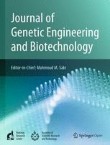Clonal fidelity investigation of micropropagated hardened plants of jackfruit tree (Artocarpus heterophyllus L.) with RAPD markers
Artocarpus heterophyllus is an important tropical agroforestry species that bears multiple applications. However, the population of this species is reduced due to various anthropogenic activities. For this reaso...

